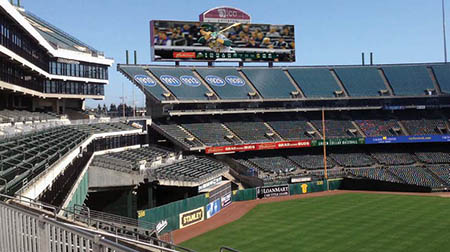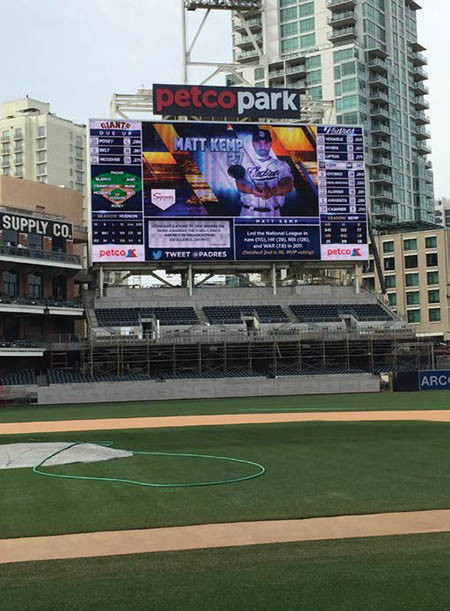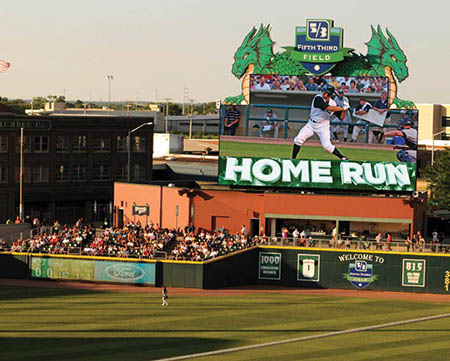Baseball’s ‘Big Picture’ Wows Fans

Oakland’s O.co Coliseum, home to the Oakland A’s MLB and Oakland Raiders NFL teams.
BALTIMORE—HD video boards at the nation’s Major League Baseball stadiums just keep getting bigger and better. And their popularity keeps going up, up, up. They’ve become so much a part of the ballpark experience that even Chicago’s venerable cathedral of the roundball arts, Wrigley Field, now features a new jumbo Daktronics HD screen in left centerfield.
When a team gets a new and improved board, it’s always news, but there’s an even newer twist this season: As technology has progressed and affordability has risen, there might even be a new board—albeit a smaller version—at a Minor League Baseball (MILB) ballpark near you.
While the trend concerns technological advances, it also reflects society. Sports fans are used to receiving quality video on their big screens, as well as their desktops, laptops and smartphones, and they want that same quality at the ballpark to see the replays, the out-of-town highlights, the mascot’s antics—and probably even “Kiss Cam.”
THE SECOND SCREEN GENERATION

The San Diego Padres’ new Daktronics board at Petco Park stands 61 feet x 123 feet and is now the third largest such screen in all MLB parks. There are about 10 MILB parks, as well as four MLB venues that are getting an HD video addition or upgrade this season, according to representatives of Brookings, S.D.-based Daktronics, the premier provider of stadium screens. Of the MLB venues, New York’s CitiField, Oakland’s O.co Coliseum and San Diego’s Petco Park are in the latter category.
To get an idea of just how big teams are going, the Padres’ new Daktronics board is 61-feet x 123-feet, or about the same size as the boards facing either sideline at AT&T Stadium in Dallas, according to Matt Coy, the Padres’ director of game day presentation. In fact, Coy noted that the new board “is the third largest in MLB,” after the installs at Seattle’s Safeco Field and at Kaufmann Stadium in Kansas City.
Get the TV Tech Newsletter
The professional video industry's #1 source for news, trends and product and tech information. Sign up below.
The overall project at Petco also includes seven LED ribbon boards “They’re all Daktronics, which is pretty much the leader,” he said. “They great thing they have is the ability to sync everything in unison with ShowControl, which is an amazing feature.”
The board’s nerve center is a Sony HD control room, which contains a new Sony 7000 switcher, with three Sony HSC-300Ks for high first, and the center and leftfield scoreboards, plus a low third handheld 300K; three Canon XJ60X9Bs, all on tripods, with Canon KJ 20 lens; with a fourth that’s in the third base dugout. In addition, two Sony PMW-500 camcorders are in the mix for ENG and supported by Wave Central RF technology that allows the shooters to wander up to one-quarter of a mile away from the ballpark. Three Evertz 4K-capable Dreamcatcher replay systems round out the mix.
Coy sees the upgrade as a necessary element of today’s game day experience. “Millennials and Gen-Xers have grown up with computers and devices,” he said, “and they want this kind of technology as part of the in-game experience.”
IN THE PICTURE

Even Minor League Baseball teams are now adopting large video screens, with the Dayton (Ohio) Dragons featuring a new Daktronics 35-foot x 65-foot screen 13HD pixel board at Fifth Third Field. In Oakland, David Don, the A’s senior director of multimedia services also has some new toys, notably two 36-foot x 146- foot Daktronics HD-13 (the “13” refers to the number of millimeters between each pixel), LED video displays that now occupy the enclosures that once housed O.co Coliseum’s Mitsubishi DiamondVision boards. Placed at the left and right field foul poles—each just outside of fair territory—they will double as end zone boards for the venue’s other tenant, the NFL’s Oakland Raiders.
The setup will include six cameras, with one hard Grass Valley LDX 80 Triax-based, with one SMPTE fiber-based LDX 86 for high frame rates; two wireless LDX 80s, with Wave Central RF wireless transmitters; and two Canon robocams mounted atop the scoreboards for beauty shots, fan cam, etc.
They will be controlled by Grass Valley Karrera switchers, with three Grass Dynos for replays: one is set up to playback at 600 fps for super slo-mo, while the other two operate at normal rates; it will also be used as the A’s main clip playback. The Daktronics DMP-8000s will also be employed for playback.
After nearly 30 years with the A’s, Don is looking forward to the versatility the boards offer. “We’re looking forward to shooting across the San Francisco Bay to capture that great sunset,” he said.
Representatives from the Cubs and Mets declined to be interviewed for this article.
SIZE MATTERS
20-35-year-olds off the streets and into the seats,” said Tony Mulder, regional sales manager for Daktronics. “That’s one reason the screens are getting bigger and bigger. And today, the screens have to average 50 feet high to incorporate true 1080i.”
Mulder said that today’s boards are driven by the switchers. “The early switchers would put out an image in a video screen format: 16:9 or 4:3; but now, all of the new displays are full sizes and they don’t fit those formats. But today’s switchers are becoming more advanced and they don’t need to follow the traditional 16:9 format.”
Also noteworthy is the anticipation of 4K in the HD video board boom; however, simply said, it has no role “due to a lack of infrastructure,” according to Marty Brown, head of business development at Daktronics. “So currently it’s not worth [the roughly doubling of] the expense, especially since it trickles down to the control room.”
Still, the equipment is becoming so advanced that getting a good-sized board into a minor league park is no longer a pipedream. Videoboards in MILB have been around for about 10 years, but have generally been about 15-feet x 20-feet, with various picture quality.
“That was considered a good size,” said Mulder, “but in recent years, they’ve become sizably bigger. Legends Park [in Tampa, Fla.] housed one of the first of the larger minor league boards,” Mulder said. “Today’s MILB screens are still typically not as large as major league screens, but you can estimate that square footage can be as large as 2,000-3,000 square feet for some of the AAA teams.”
Werner Park, home of the Omaha Storm Chasers, is among the MILB venues that will have a new board this season—a 25-foot x 45-foot Daktronics board with a 13HD pixel layout that is about 50 percent bigger than the previous board, said Rob Sternberg, the teams’ marketing and promotions manager. The park’s equipment roster has also been upgraded to now include six new HD cameras, which will complement the JVC GY-HM710U, with a new Newtek TriCaster, which acts as a switcher and video playback.
“We hope that the addition of new hardware and software continues,” he said. “We’ll keep some of our previously owned Newtek 3Play replay operating software that we bought in 2014, with a new RF Wave Central wireless system.
The Iowa Cubs and the Dayton Dragons are also on board with the trend. The Cubs have a new 24-foot x 62-foot Daktronics 15HD pixel layout at Principal Park that will be powered by the Daktronics Show Control system, while the Dragons will show their new 35-foot x 65-foot screen 13HD pixel board at Fifth Third Field.
YESTERDAY’S GONE
When discussing ballpark screens, Mulder notes that it’s important to remember that viewers can get all of the information on TV that they haven’t been able to get at the ballpark; and today, the equivalent of a TV screen is in their hands (whether the fans in the stands can access adequate bandwidth is another issue).
“There is so much information with baseball, the out-of-town scores, etc.,” he said. “The fans get that at home and they want that at the ballpark, too.”
As for the baseball fans of a certain age who long for the days when their ballpark experience was not interrupted/accentuated by modern technology and the obligatory sensory overload, Mulder said that he feels it’s an expected part of the experience today.
“When we started building the new screens in recent years for the Twins and the Royals, we never thought they’d get any bigger,” he said. “We know that there are purists out there who want to just watch the game like they did back in the day, but we’ve never had a complaint from anyone who thought the screen was too big.”
Mark R. Smith has covered the media industry for a variety of industry publications, with his articles for TV Technology often focusing on sports. He’s written numerous stories about all of the major U.S. sports leagues.
Based in the Baltimore-Washington area, the byline of Smith, who has also served as the long-time editor-in-chief for The Business Monthly, Columbia, Md., initially appeared in TV Technology and in another Futurenet publication, Mix, in the late ’90s. His work has also appeared in numerous other publications.

